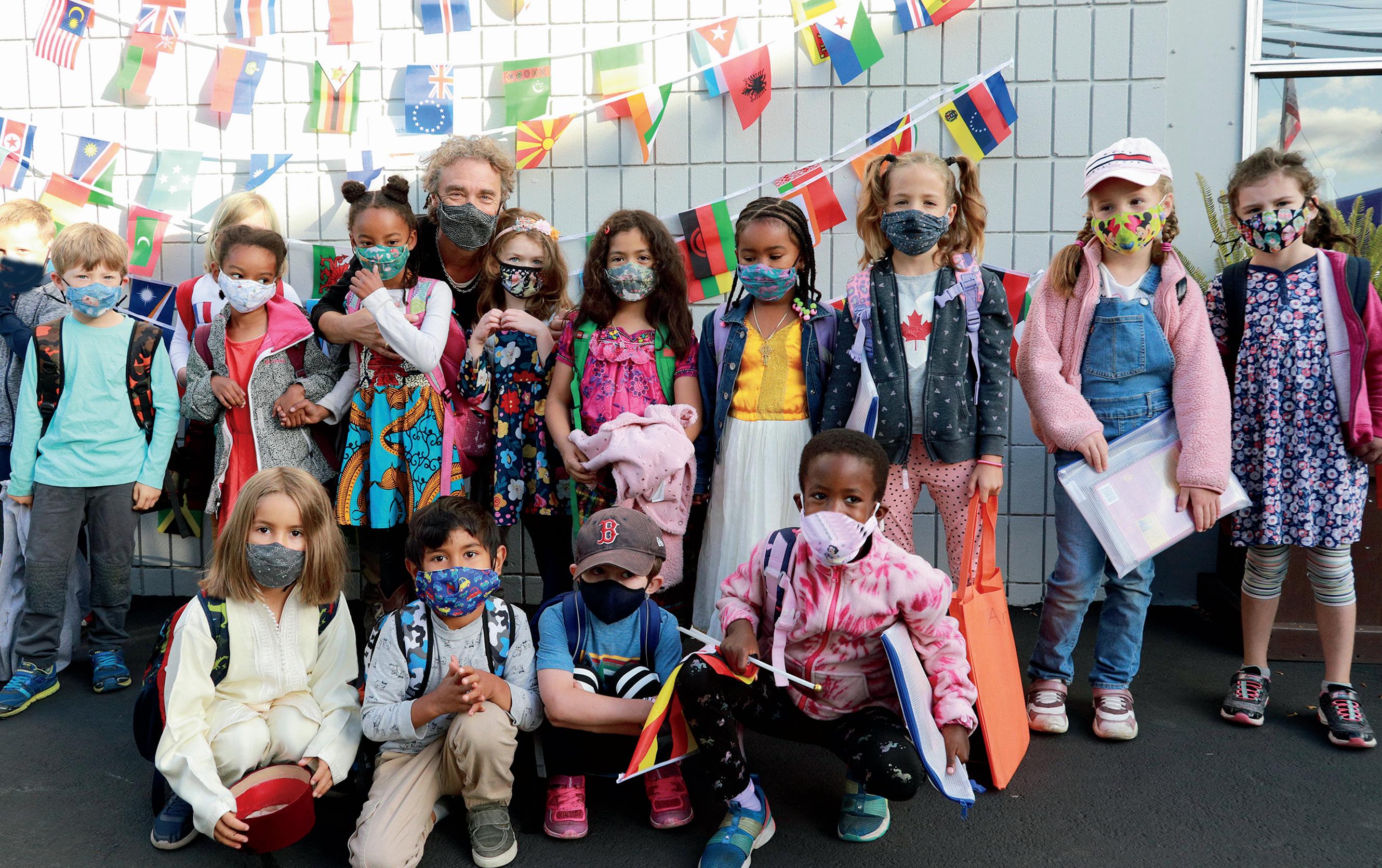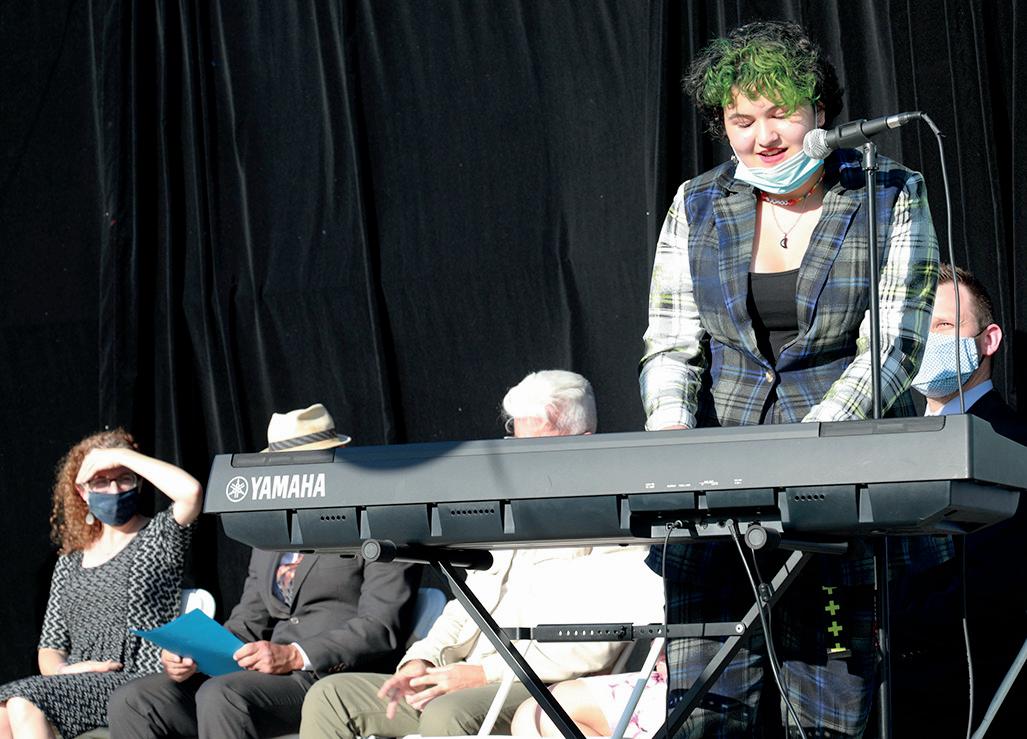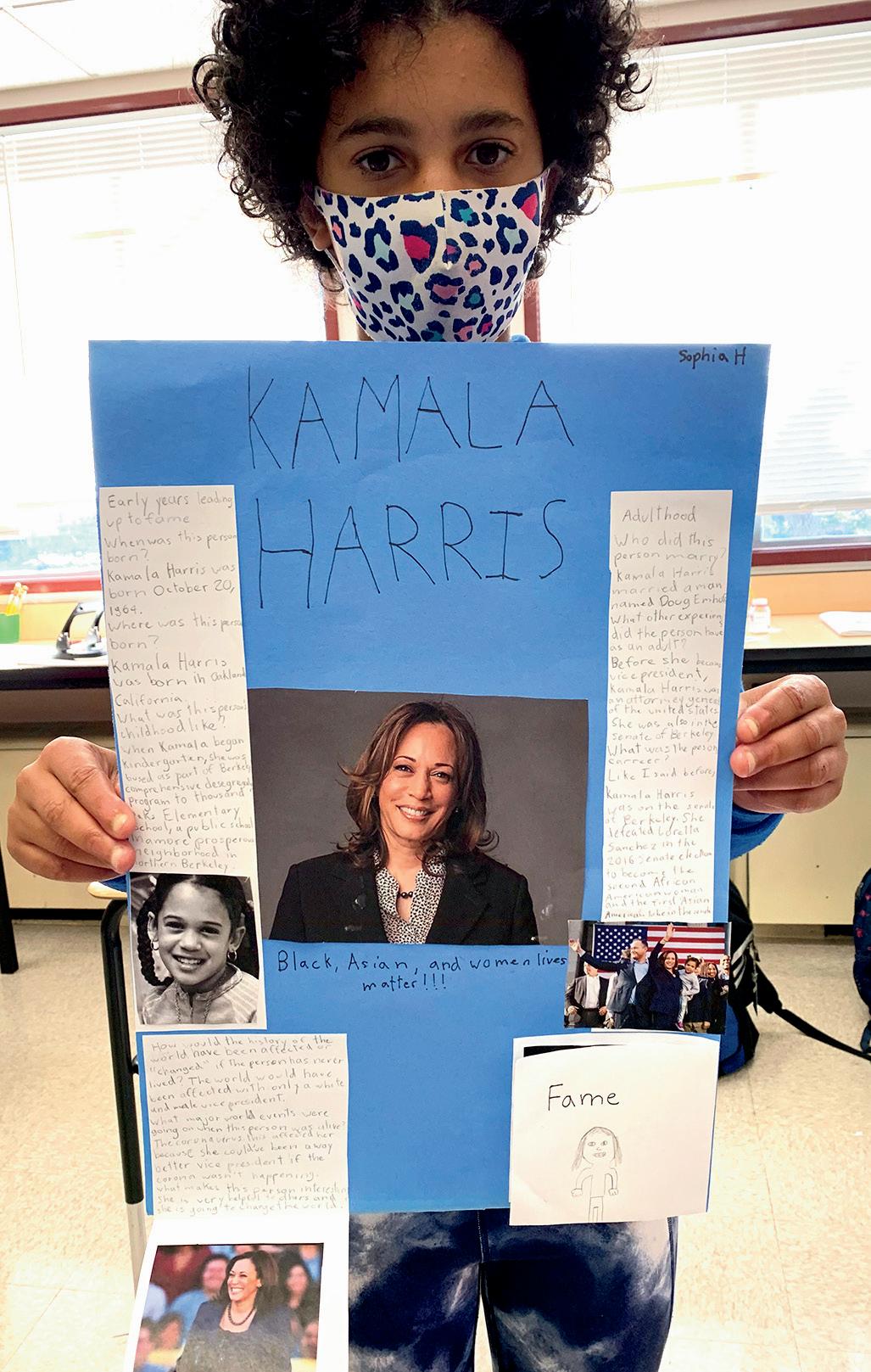
12 minute read
Highlights from the Year
MAKING OUR CAMPUS SAFER
Alfonso de la Torre is EB’s Facilities Manager and has more than fifteen years of experience in grounds, landscape, and building maintenance and project management in various Bay Area companies and organizations. During his career, Alfonso has overseen many construction projects and has been an Operations Manager and an Account Manager for landscape and construction companies. Alfonso is fully bilingual in English and Spanish, and holds a Bachelor of Science degree in Criminal Justice with an option in Law Enforcement. Why is safety such an important value to EB, especially these past few years?
Advertisement
Keeping these kids safe has been a challenge, but still crucially important. Not only do we consider the security of our students—making sure visitors on campus have been screened, which has been a priority for many years—but now with the continued spread of COVID, we need to make sure that their health is a priority as well. We don’t want the kids to get sick and possibly increase infection, especially with the environment that’s going on right now. We’ve been working on making our campus safe and keeping everyone together, learning.
What have you been doing to keep the campus safe for everybody?
One major structural improvement was that we redesigned our ventilation system. We installed MERV 13 air filters, which purify air-borne diseases and smoke particles. We also installed UVC lights in our filtration systems to kill any bacteria in the air. We added one-way traffic signs in the hallways and put in safety barriers in classrooms to create smaller pods and to keep students safe while optimizing learning. For the home learning cohorts, we added a lot of technology in the classroom, like projectors and screens, so that teachers could simultaneously teach in the classroom while accommodating our students at home. We were fortunate to offer PCR testing through Curative after each break during the academic year. When COVID cases were high in the county, we were able to test our community twice a week, and when numbers were dropping again, we were still testing once a week. For the students, we did antigen testing twice a week and teachers were obligated to do PCR testing twice a week, when cases were high. We have been pretty successful with our testing measures and protocols!
Is there anything you are hopeful about in the future? I’m super excited that social distancing has pushed us in a good direction, so in the 2021–2022 school year, we are able to have more students mingling with one another. Of course, we’ll still have the classrooms divided, but each grade level will be able to interact with one another, rather than sticking to their specific pod. Hopefully things will continue to improve!
EXPERIENTIAL LEARNING IN THE VIRTUAL SPACE
Creating meaningful experiences, especially outside the normal classroom setting, was particularly challenging to manage last year. Experiential learning and field trips test students’ skills in applying their knowledge in real-world situations or via discussions outside the classroom. Although it was difficult to organize our normal field trips this year, EB teachers were quite savvy, and came up with creative solutions to engage students inside the virtual classroom.
In Sue Campbell’s classroom, the G6 and G7 students met with award-winning author Ji-Li Jiang during an hour-long zoom in May 2021. They talked about her memoir, Red Scarf Girl, and asked questions about her life during and after the Cultural Revolution in China. Ji-li Jiang, who is now a resident of the Bay Area, was born in Shanghai, China in 1954 and wrote Red Scarf Girl to document surviving the Chinese Cultural Revolution and overcoming her childhood difficulties. Not only were students privy to an intimate meet and greet, but Ji-Li Liang also presented a short film about her family’s experience that included archival footage of life in revolutionary and post-revolutionary China.
In recent years, EB has warmly welcomed the San Francisco Opera for a program known as Opéra à la carte, a highly-regarded academic program where students perform alongside professional artists in a 45-minute adaptation of a classic opera. Even though some of the Lower School classes and the SF Opera’s professional artists weren’t able to come together in person, they still organized and performed a virtual adaptation of the Magic Flute by Wolfgang Amadeus Mozart. Students memorized lines in advance, were coached by artists in a dress rehearsal, and then with some props, scenery, and costumes, performed for their class online. Despite the change in live performance, students enjoyed being part of this process of collaboration and artistic production.
While many of us missed out on traveling, teacher Elodie Resurreccion gladly welcomed two new extraordinary traveling “students” into her virtual G3 classroom. Based on The Flat Stanley Project, students were introduced to two large cut-out paper dolls, known as Clément and Clémentine, and a journal that has traveled around many classrooms in France, Canada and the United States in the last several years. Over the years, each host classroom shows Clément and Clémentine their school, town and way of life, and then recounts their adventures along with accompanying photos in the journal. The children not only were able to practice their written French, but were also eager to show their new friends around Berkeley—visiting their classroom, UC Berkeley campus, the basketball court, Wildcreek Canyon, and EB chickens! One of our EB parents even knitted a scarf for Clémentine for her trip back to France. The goal of the project is to increase French reading and writing skills, and also teach children about people and cultures from different places—what a great opportunity to “meet” other children from other French-speaking locations, even during a pandemic!
HIGHLIGHTS FROM THE YEAR
VIRTUAL TEDXYOUTH@EB
By the end of November 2020, EB Middle School students had fully adapted to the virtual classroom. Teachers Sue Campbell and Gabrielle Hedlund, along with the rest of the TEDx Committee, launched EB’s first virtual TEDxYouth conference, to exchange powerful ideas online despite our hybridized learning conditions. Over 100 attendees from all over the country, and the world, tuned in for EB’s 6th Annual TEDxYouth Conference titled “Uncharted.” Hosted by KQED Morning News Anchor and EB parent Brian Watt, a group of alumni and student speakers confidently shared their ideas on current issues that are affecting health, climate, biodiversity, pop culture, human rights, and access to technology.
Our alumnae speakers and young current students had an array of empowering new ideas that invited the audience to think about the future in a new way.
Kate Solomon-Tilley (‘01) was invited to talk about her personal experience fostering children from the border.
Meaghan McGrath (‘02) who currently works for an innovative vertical farming company, spoke about the future of farming and sustainable food production.
Maddy Kelly researched how and why women’s voices are historically criticized as too high-pitched and “annoying,” especially the voices of women in leadership.
Students Clara Bartlett and Jules Droz dove into the then-rapidly developing science of fighting COVID and creating a vaccine. Bodie Oakley and Divvya BenDavid talked about the power of pop culture through the lens of graphic novels and cosmic horror, respectively.
Sammy Kirk and Juniper Hedlund chose to focus their topics on animals, wondering about their moral reasoning and how wildlife is severely affected by wildfires. Kylie Chew dove into the future of virtual reality and how it could offer a more creative alternative to conferencing online.
Maëlle Griffin discovered the science of music as a form of therapy, and how it can stimulate body memory and parts of the brain that re-engage our senses and emotions.
Thank you to our 2020 TEDxYouth@EB speakers! We are so very impressed by the curiosity, poise, and oratory skills of our young students and alumni!
Visit tedxyoutheb.com to watch the videos.

WHAT IS HYBRID LEARNING?
Jeffrey Miles is our current English Program Pedagogical Coordinator and Instructional Coach. An experienced educator, previously assistant principal at Lafayette School District, Jeffrey is passionate about teaching and learning and extremely student-centered. He has extensive knowledge as a learning specialist and holds two MA degrees: one in Educational Leadership and one in Teaching and Learning.
What is hybrid learning?
Hybrid learning is a model where children are in the classroom part of the time and part of their instruction is happening over the computer, over Zoom, over an asynchronous platform, like SeeSaw. As we all know, Covid has shifted education and the world. Being able to provide in-person, physical access to the school is really important from our perspective. It provides stability for kids, a place learning happens. But, we knew that we weren’t going to be able to do that for all our kids, and some of our families opted for remote learning this entire year. So, we had to figure out how to support kids while they were still at home.
What are some of the challenges of hybrid learning that are unique to a bilingual school? In terms of challenges, there are not as many French online resources as there are in English and Spanish. Trying to find valuable and appropriate bilingual materials was a little tricky, but we were successful in securing French asynchronous and synchronous resources. Teachers found creative ways to boost verbal exposure online for children who are not from a Francophone family, whenever possible. Also, our teachers had to learn how to navigate this unfamiliar teaching process quickly. Scheduling meetings for our specialists and teachers to make sure we had all the pieces we needed to offer a robust curriculum was a juggling affair. What were some of the unforeseen successes of hybrid learning? Our kids and teachers are more technologically savvy than they’ve ever been before. They are very good at navigating platforms, at finding their assignments, and at communicating with their teachers. And, in fact, it has really fostered some maturity in the kids, especially the younger ones. Our kindergarteners, for example, whom we wouldn’t normally expect a lot from in terms of technology, now know how to log on, to use SeeSaw, and interact with technology in meaningful ways.

Are there some aspects of hybrid learning that worked really well? Is there anything that we can and should incorporate into our learning model in the future?
HIGHLIGHTS FROM THE YEAR
With hybrid learning comes a hybrid communication style with families, and we’ve been able to get more people at more meetings, because we were able to meet them where they are, to get them online, and connected. That has been a bonus to help us communicate more openly with the parents. The kids had a lot more independent work that they then brought into the classroom, instead of just doing it in the classroom. I think overall everyone became more open to adapting and changing, accepting that everyday has something new and different to offer.
DEIJ: COMMITTING TO A BETTER SCHOOL
EB was founded by a group of dedicated parents with a vision to provide their children with a bilingual education in a rich, multicultural environment. As the community has continued to grow and embrace new members, we have navigated, and we continue to navigate, the challenges and complexities of developing shared understandings. Always striving to be intentionally inclusive, EB also recognizes the continued work needed to make our school equitable, diverse, and committed to social justice.

This year, EB pledged to be an anti-racist school, and committed to Diversity, Equity, Inclusion, and Justice (DEIJ) programming for our entire community. During the 2020–2021 school year, we engaged in a year-long learning process with Dr. Derrick Gay, a diversity and inclusion strategist and renowned DEI leader. Our EB teachers, staff, students, families, and trustees participated in a series of interactive workshops to learn about the fundamentals of race, racial bias, the double-edged sword of diversity, how to foster an inclusive school, and how to talk about race. These workshops have given us a common language to use when discussing DEIJ matters, and a shared understanding of why the work is so needed.
Additionally, with Dr. Gay’s help, the EB DEIJ committee—composed of twelve members including faculty, administrators, parents, trustees and alumni—collaborated with the Board’s DEIJ committee to create a three-year DEIJ Strategic Plan. The goals of the plan are multifold and include 1) guiding EB through the next three years; 2) reinforcing EB’s mission, vision and values, 3) helping to create a community that is more inclusive and representative of the full diversity of the East Bay and our student body; 4) facilitating and supporting a more diverse, inclusive, equitable and socially just community.
EB has identified four areas of focus for its DEIJ work: (1) Recruitment and Retention; (2) Program and Curriculum; (3) Finance and Financial Assistance; and (4) Events and Fundraising. Each of these areas contain a set of objectives with actionable items for measurable improvements. The first piece of the plan will include a self-assessment and climate survey, to get an accurate sense of
where we are now as a school and to identify key areas of improvement to align with our plan. There are three closely connected entities working to implement these objectives: the school’s DEIJ committee (alongside the DEIJ Task Force—faculty and staff), the Board DEIJ committee and the Parents’ Association DEIJ Advisory Board.
With the support of the PA’s Diversity Chair and DEIJ Advisory Board, several parent and student groups were created with the goal of providing support and resources to different members of our community.
The EB Families of Color Affinity Group works to provide families the opportunity to build community, solve challenges, and share insights and resources related to raising brilliant, resilient, and dynamic children of color.
The EB Dads Antiracist Book Group provides a space for dads of all backgrounds to explore issues of racial justice in a supportive, non-judgmental environment through books and movies with antiracist themes.
HIGHLIGHTS FROM THE YEAR
The Learning Differences Support Group aims to provide support and resources for EB families whose children have been diagnosed with a learning difference or may suspect a learning difference. The LGBTQ+ Alliance is a Middle School student group that aims to provide a safe space for LGBTQ+ identifying students and allies, as well as to educate fellow students and teachers about some of the challenges facing our identifying students, and ways in which they can be best supported during their middle school journey.
These groups and objectives have helped keep DEIJ issues in focus and were created in response to real needs within the community. We recognize that this is an ongoing exercise in learning and growing, and one that will not be completed overnight, if ever. As a community, we are neither perfect nor infallible. We strive to be compassionate with one another, and to recognize that we are all on a collective journey of understanding and action.
More information about EB’s DEIJ efforts can be found on our website.
EVERY ONE IS WELCOME AT EB!



